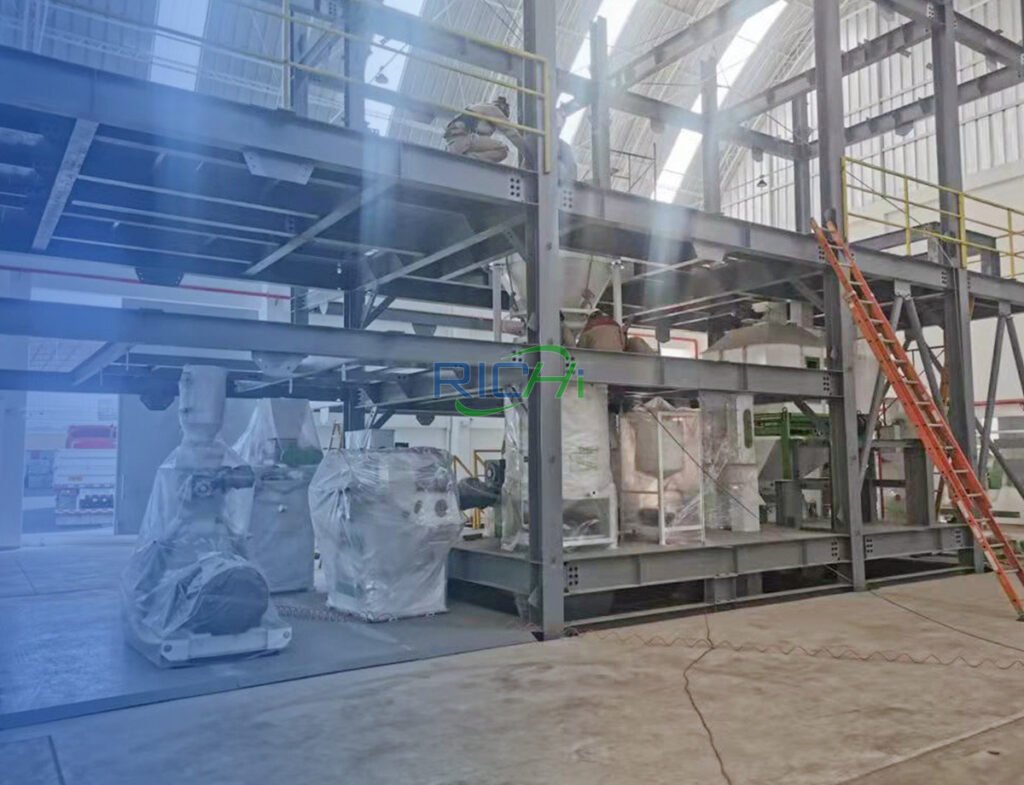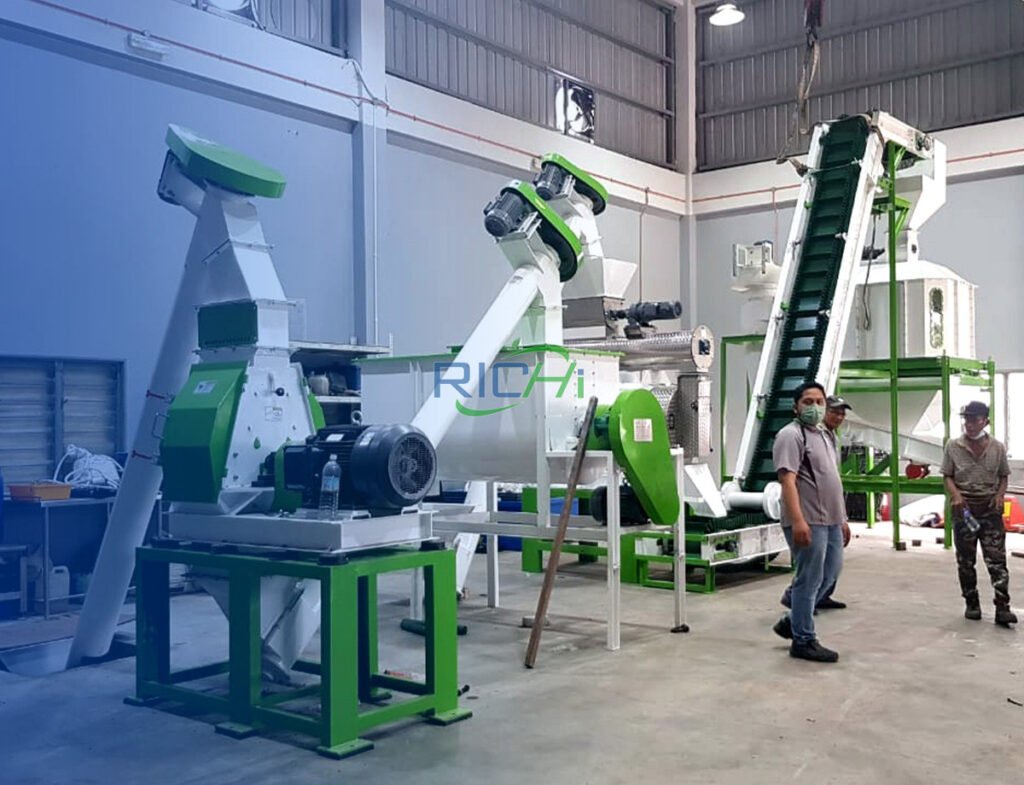The installation and commissioning of a 3-4t/h animal feed manufacturing machine are critical steps in ensuring that the equipment operates efficiently and produces high-quality feed pellets. Proper installation and commissioning can minimize downtime, enhance productivity, and extend the lifespan of the machine. This article outlines key considerations and best practices for the successful installation and commissioning of an animal feed manufacturing machine.
1. Site Preparation
Before the arrival of the animal feed manufacturing machine, thorough site preparation is essential.
- Space Requirements: Ensure that there is adequate space for the machine, including room for operation, maintenance, and future expansion. The layout should facilitate smooth workflow and easy access to all components.
- Foundation: A solid foundation is crucial for the stability and performance of the machine. The foundation should be level and capable of supporting the weight of the equipment. Concrete foundations are commonly used, and they should be allowed to cure properly before installation.
- Utilities: Ensure that the necessary utilities, such as electricity, water, and compressed air, are available and properly connected. Verify that the electrical supply matches the machine’s specifications to prevent operational issues.
2. Equipment Delivery and Inspection
Once the machine arrives at the site, conduct a thorough inspection before installation.
- Check for Damage: Inspect the equipment for any signs of damage that may have occurred during transportation. Report any issues to the supplier immediately to address potential warranty claims.
- Verify Components: Ensure that all components and accessories are included as per the purchase order. This may include the main machine, feeders, conditioners, and any additional equipment necessary for the production process.

3. Installation Process
The installation process should be carried out by qualified personnel to ensure that the machine is set up correctly.
- Follow Manufacturer Guidelines: Adhere to the manufacturer’s installation manual and guidelines. This documentation provides specific instructions on assembly, alignment, and connections that are crucial for proper operation.
- Assemble Components: Carefully assemble the machine components, ensuring that all parts are securely fastened and aligned. Pay special attention to the installation of the pellet mill, conditioning unit, and any associated conveyors.
- Electrical Connections: Connect the electrical components according to the wiring diagram provided by the manufacturer. Ensure that all connections are secure and that safety measures are in place to prevent electrical hazards.
- Calibration: After assembly, calibrate the machine settings according to the manufacturer’s specifications. This includes adjusting the die clearance, roller pressure, and feed rates to optimize performance. (Related post: small feed making machine)
4. Commissioning Process
The commissioning process involves testing the machine to ensure it operates correctly and meets production requirements.
- Initial Testing: Conduct initial tests without raw materials to check for proper operation. Monitor the machine for any unusual noises, vibrations, or overheating. This step helps identify any installation issues that need to be addressed before full-scale production.
- Feed Testing: Once initial testing is complete, introduce small quantities of raw materials to the machine. Monitor the feed flow, pellet formation, and overall performance. Adjust settings as necessary to achieve the desired pellet quality and production rate.
- Performance Monitoring: During the commissioning phase, closely monitor key performance indicators such as output capacity, energy consumption, and pellet quality. This data will help identify any areas for improvement and ensure that the machine operates efficiently.
5. Training Personnel
Proper training of operators and maintenance personnel is essential for the successful operation of the animal feed manufacturing machine.
- Operational Training: Provide comprehensive training on the machine’s operation, including how to start and stop the machine, adjust settings, and monitor performance. Operators should understand the importance of maintaining consistent feeding rates and monitoring raw material quality.
- Maintenance Training: Train maintenance personnel on routine maintenance tasks, such as lubrication, cleaning, and inspection of components. This training will help ensure that the machine remains in good working condition and can prevent costly breakdowns.
- Safety Protocols: Educate all personnel on safety protocols related to the operation and maintenance of the machine. This includes the proper use of personal protective equipment (PPE) and understanding emergency shutdown procedures.
6. Documentation and Record Keeping
Maintaining accurate documentation is crucial for ongoing operations and maintenance.
- Installation Records: Keep detailed records of the installation process, including any adjustments made and issues encountered. This documentation can be valuable for future troubleshooting and maintenance.
- Maintenance Logs: Establish a maintenance log to track routine inspections, maintenance activities, and any repairs performed. This log can help identify trends in wear and tear and inform future maintenance decisions.
- Performance Data: Document performance metrics over time to track changes and identify potential issues. Analyzing this data can help optimize operating conditions and improve overall efficiency.
7. Regular Follow-Up
After the commissioning process, regular follow-up is essential to ensure continued performance and address any emerging issues.
- Post-Commissioning Support: Maintain communication with the equipment manufacturer for post-commissioning support. This may include technical assistance, spare parts availability, and additional training as needed.
- Continuous Improvement: Encourage operators and maintenance personnel to provide feedback on the machine’s performance. Use this feedback to make continuous improvements to operating procedures and maintenance practices.
Conclusion
The installation and commissioning of a 3-4t/h animal feed machine require careful planning, attention to detail, and adherence to best practices. By focusing on site preparation, proper installation, thorough testing, personnel training, and ongoing documentation, businesses can ensure that their pellet manufacturing operations run smoothly and efficiently.Investing time and resources in the installation and commissioning process will pay off in the long run by reducing operational costs, improving product quality, and enhancing the overall reliability of the animal feed manufacturing equipment. As the demand for high-quality animal feed continues to grow, ensuring a well-functioning production system will be crucial for success in the competitive feed industry.

